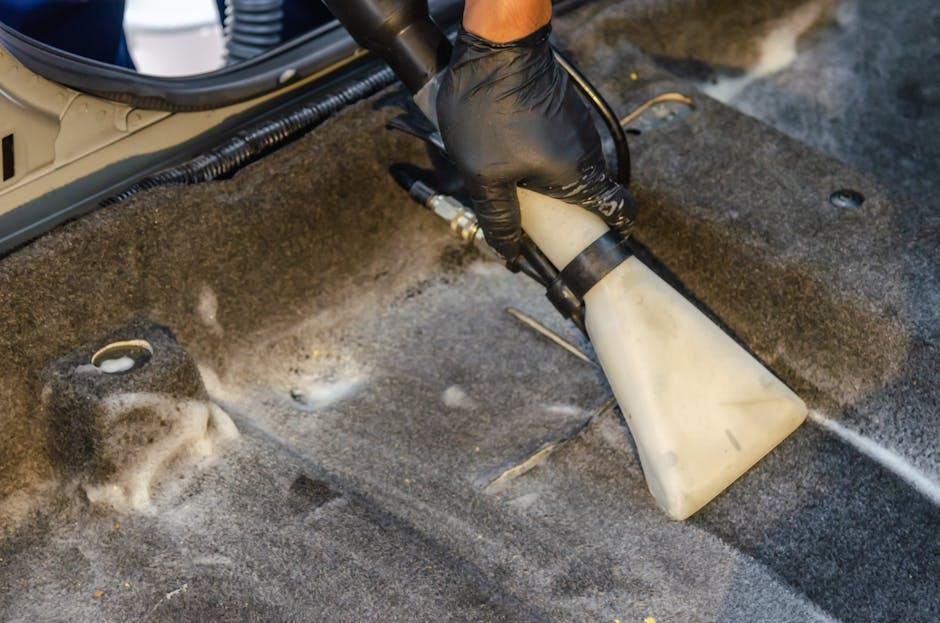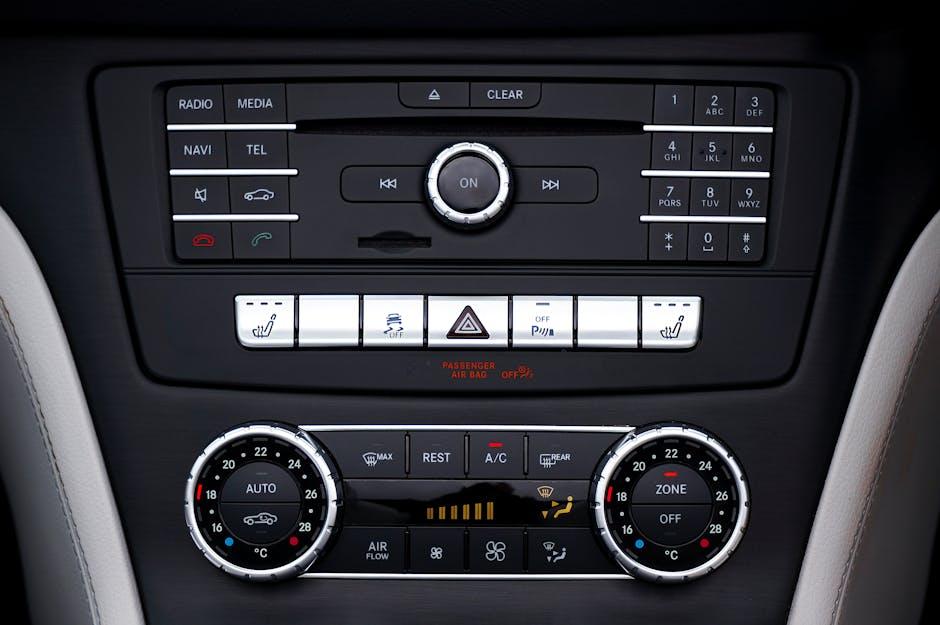Step into your car, take a deep breath, and … wait, what’s that smell? Whether it’s the lingering scent of last week’s takeout, the stubborn mustiness from a rainy day, or the faint trace of a forgotten gym bag, odors in your vehicle can turn every drive into an olfactory challenge. Fortunately, banishing these unwelcome aromas doesn’t require a magic wand—just a little know-how and the right approach. In this article, we’ll explore practical and effective ways to remove odors from your car, helping you transform your space into a fresh and inviting haven on wheels.
Table of Contents
- Understanding the Root Causes of Car Odors
- Effective Cleaning Techniques for Interior Surfaces
- Harnessing Natural Deodorizers for Freshness
- Utilizing Commercial Odor Eliminators Safely
- Maintaining Ventilation to Prevent Lingering Smells
- Regular Upkeep Tips to Keep Your Car Smelling Clean
- Q&A
- The Way Forward

Understanding the Root Causes of Car Odors
Car odors often stem from more than just lingering scents; they originate from a variety of sources that accumulate over time. Moisture trapped under the seats or within carpets creates the perfect breeding ground for mold and mildew, while forgotten food crumbs and spills invite bacteria and insects to settle in. Additionally, cigarette smoke can cling stubbornly to upholstery and vents, embedding itself deep in the fibers and plastic, making it a persistent challenge to eliminate.
Understanding where these smells come from helps in targeting the problem efficiently. Here are common culprits to consider:
- Stagnant water from leaking windows or air conditioning
- Pet dander and accidents
- Old or dirty cabin air filters
- Hidden sources like under-seat storage or floor mats
| Odor Cause | Typical Source | Best Removal Method |
|---|---|---|
| Mildew | Water spills, damp carpets | Deep cleaning & dehumidifier |
| Food Odors | Leftovers, spills | Thorough vacuum & odor neutralizer |
| Smoke | Cigarettes, vaping | Steam cleaning & ozone treatment |

Effective Cleaning Techniques for Interior Surfaces
To tackle stubborn odors trapped in your car’s interior, it’s essential to adopt cleaning methods that reach all surfaces — from upholstery to dashboards. Start with a thorough vacuuming to remove loose dirt and debris that may trap smells. Next, use a microfiber cloth dampened with a gentle, all-purpose cleaner to wipe down hard surfaces such as the dashboard, door panels, and center console. These materials tend to absorb odors over time, especially if exposed to smoke or food spills. For fabric seats and mats, a deep steam clean or application of a fabric-safe enzymatic cleaner will break down odor-causing molecules without damaging the fibers.
Don’t forget the hidden spots where odors can lurk: under seats, inside air vents, and in seat crevices. Use a small brush or compressed air to clean these tricky areas thoroughly. To boost freshness, place activated charcoal bags or baking soda containers in the car overnight to naturally absorb lingering smells. Below is a concise guide to effective interior cleaning agents and their ideal uses:
| Cleaning Agent | Best For | Note |
|---|---|---|
| Microfiber Cloth + All-Purpose Cleaner | Dashboards, Doors, Consoles | Gentle, non-abrasive |
| Enzymatic Cleaner | Fabric Seats & Mats | Breaks down organic odors |
| Activated Charcoal | Odor Absorption | Natural, reusable |
| Baking Soda | Deodorizing Traps | Safe, inexpensive |

Harnessing Natural Deodorizers for Freshness
Freshen up your car naturally by turning to simple ingredients found right in your kitchen or garden. Items like baking soda, activated charcoal, and essential oils have remarkable odor-absorbing properties without overpowering your interior with artificial scents. For example, a small open container of baking soda placed under a seat can quietly trap musty smells over a few days. Meanwhile, activated charcoal bags are great for continuous use, capturing odors while releasing no fragrance, perfect for those sensitive to strong smells.
To amplify freshness, incorporate natural aromatics that uplift the space subtly and healthfully. Consider:
- Citrus peels: Lemon or orange peels nestled in a breathable bag can impart a bright, clean aroma.
- Herb sachets: Lavender, rosemary, or mint sachets tucked in glove compartments add a refreshing touch.
- Essential oil diffusers: Using a few drops of eucalyptus or cedarwood oil helps neutralize odors while creating a calming environment.
These natural options not only remove unpleasant scents but also contribute to a wholesome driving experience, proving that you don’t need harsh chemicals for a truly fresh cabin.

Utilizing Commercial Odor Eliminators Safely
When using commercial odor eliminators in your vehicle, it’s important to prioritize safety without compromising effectiveness. Always start by reading the product label carefully to understand proper application methods and any precautions. Avoid using these products in an enclosed space without ventilation, as fumes can build up and cause discomfort or health issues. To maximize results, test the product on a small, inconspicuous area first, ensuring it won’t damage upholstery or interior materials. Remember to wear gloves if recommended and keep the product out of reach of children and pets.
Different odor eliminators rely on various active ingredients, so it’s beneficial to know which suits your car’s environment best. Here’s a quick comparison of common types:
| Type | Best For | Precautions |
|---|---|---|
| Enzymatic Sprays | Organic smells (food, pet odors) | Avoid eye contact; ventilate area |
| Activated Charcoal Bags | Ongoing odor prevention | Safe, minimal precautions |
| Ozone Generators | Strong, persistent odors | Run in empty car; no humans or pets present |
- Store products properly to maintain efficacy and avoid accidents.
- Allow sufficient drying time before closing car doors to trap noxious vapors inside.
- Repeat application as needed, but avoid overuse to prevent buildup.

Maintaining Ventilation to Prevent Lingering Smells
Proper airflow is essential for banishing stale odors from your vehicle. When you keep fresh air circulating, you help disperse trapped smells, making your car environment more pleasant. Regularly opening windows for a few minutes, especially after driving through areas with smoke, food smells, or strong fragrances, helps flush out the lingering particles that settle in upholstery and carpets. Additionally, using the car’s ventilation system with the air conditioner or heater set to fresh air intake instead of recirculation pulls in new air and pushes out the old, musty scents.
Consider incorporating these simple habits to maintain clean air inside your car:
- Run ventilation fans: Use them on low settings overnight to keep air moving.
- Keep cabin filters clean: Replace them regularly to ensure they trap pollutants effectively.
- Park wisely: Whenever possible, park in shaded or open areas that promote natural airflow.
| Ventilation Tip | Frequency |
|---|---|
| Open windows briefly | Daily |
| Replace cabin filter | Every 12,000 miles |
| Activate fresh air mode | Each trip |

Regular Upkeep Tips to Keep Your Car Smelling Clean
Maintaining a fresh car interior goes beyond just occasional cleaning; it requires consistent habits that prevent odors from settling in. Make it a routine to vacuum your car’s carpets and seats weekly, as dirt and food particles often become the hidden culprits behind lingering smells. Regularly wiping down the dashboard, steering wheel, and door panels with a mild cleaner can also stave off buildup of dust and grime that trap odors. Consider swapping out your car’s air cabin filter every 12,000 to 15,000 miles; a clean filter drastically improves air quality and reduces musty smells.
Small habits can make a tremendous impact when it comes to freshness:
- Keep windows slightly ajar on dry days to promote ventilation.
- Avoid eating inside the vehicle to eliminate spills and food smells.
- Place a small sachet of activated charcoal or baking soda under the seats to naturally absorb odors.
- Use essential oil diffusers or air fresheners strategically, but avoid overpowering scents.
| Maintenance Task | Recommended Frequency | Benefit |
|---|---|---|
| Vacuum interior | Weekly | Removes dust and debris reducing odor sources |
| Wipe surfaces | Bi-weekly | Prevents grime buildup that traps smells |
| Replace cabin air filter | Every 12,000-15,000 miles | Improves air circulation and freshness |
| Ventilate car | Daily (when possible) | Reduces moisture and stale air |
Q&A
Q: Why do cars develop unpleasant odors in the first place?
A: Cars can harbor a variety of smells due to trapped moisture, food spills, pet dander, cigarette smoke, and even mildew in the upholstery or carpets. The sealed environment of a vehicle often amplifies these odors, making them harder to ignore over time.
Q: What’s the first step to tackling car odors effectively?
A: Start with a thorough cleaning. Remove all trash, vacuum carpets and seats, wipe down surfaces, and wash floor mats. A clean interior lays the groundwork for successful odor removal by eliminating the primary sources.
Q: Are air fresheners enough to eliminate bad smells?
A: Air fresheners can mask odors temporarily, but they don’t address the root cause. To truly remove odors, you need to eliminate the source, whether it’s mold, spills, or trapped debris, rather than just cover it up.
Q: How can I use natural remedies to freshen my car’s smell?
A: Natural deodorizers like baking soda, activated charcoal, or coffee grounds are excellent at absorbing odors. Leave a small container or sachet in your car overnight or for several days to help neutralize unwanted smells organically.
Q: When is it appropriate to use specialized odor removers or ozone generators?
A: For persistent, stubborn smells—like smoke or mildew—specialized enzymatic cleaners or ozone generators can break down odor-causing molecules. Ozone treatments should be used cautiously and typically by professionals, as ozone can be harmful if misused.
Q: How can I prevent future odors from taking hold?
A: Good habits are key. Avoid eating in the car, clean spills immediately, ventilate regularly by opening windows, and periodically clean upholstery and air vents. Using a moisture absorber can also keep mildew at bay in humid climates.
Q: Is it worth seeking professional detailing services for odor issues?
A: Definitely. Professional detailers have specialized tools and products for deep-cleaning and odor removal that go beyond typical DIY methods, making them ideal for tough or long-standing smells.
Q: Can HVAC systems contribute to car odors?
A: Yes, mold and bacteria can grow in the air conditioning system. Running the fan on high for a few minutes with fresh air intake can help dry out moisture. Consider having your AC system cleaned if odors persist.
The Way Forward
No matter the cause, persistent odors don’t have to be a permanent passenger in your car. With a little care, the right tools, and a touch of patience, you can transform your vehicle into a fresh, inviting space—ready for every journey ahead. Breathe easy, hit the road, and let your car’s atmosphere reflect the comfort and cleanliness you deserve.

